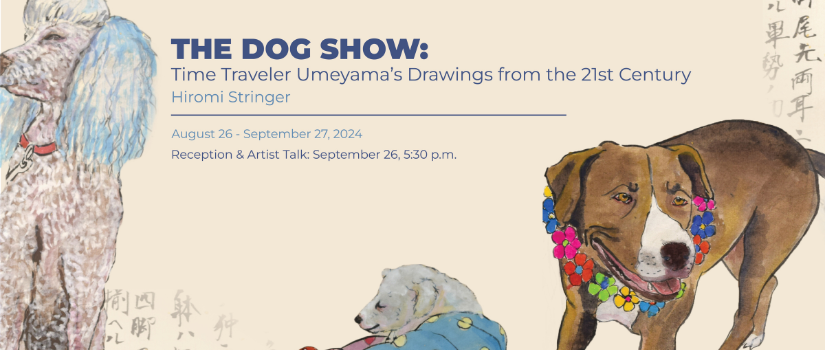The School of Visual Art and Design’s McMaster Gallery presents its first exhibition of the 2024 – 2025 academic year, The Dog Show: Time Traveler Umeyama’s Drawings from the 21st Century, featuring the imaginative artwork of Hiromi Stringer. More than a collection of charming dog portraits, the exhibition examines how humans have transformed our beloved canine companions over the past two centuries.
There are over 360 globally recognized dog breeds today, each distinguished by unique physical and behavioral traits. But our modern breeds are a recent phenomenon, shaped by forces of rapid globalization and human influence. Over the past 150 - 200 years, most dog breeds were developed through meticulous artificial selection and intentional breeding to achieve specific traits. The breeds we have manufactured reflect human desires, ambitions, and shifting cultural norms.
A Time Traveler's Perspective
Artist Hiromi Stringer's immersive exhibition invites visitors to examine the evolution of dog breeds through the eyes of fictional character Shoei Umeyama, a Japanese scholar from the 1850s. In this whimsical narrative, Umeyama travels through time to the 21st century, conducting fieldwork and sketching the diverse and intriguing dog breeds he encounters in North America and Germany. Upon his return to Japan, Umeyama publishes his drawings and findings in the Umeyama Reports, creating a comprehensive catalog of unfamiliar Western dog breeds.
In isolated Edo-era Japan (1603-1868), foreign dogs would have been regarded as exotic and prohibitively expensive, accessible only to the wealthy. Trading these dogs presented a potentially lucrative business opportunity. As a scholar employed by the local government, Umeyama was assigned the task of raising funds for his administration. By producing detailed drawings and reports on 21st-century dog breeds, Umeyama envisioned himself as a time-traveling dog importer. According to Stringer, Umeyama's drawings were designed to help him market these dogs and identify the most desirable breeds back home in Japan. His goal was to use this information to target high-demand breeds and maximize profits.
"When Umeyama saw dogs in North America and in Germany in the 21st century, the diversity of physical appearances amazed him," artist Stringer says. “To him, there were no conceptual differences between pure breed or mongrel. He truly appreciated unique and one-of-a-kind appearances of mutt dogs and saw business opportunities, resulting in him creating a lot of drawings of them."
As visitors step into McMaster Gallery, they will find it transformed into the Umeyama Time Teleportation Museum (UTTM)—a fictional contemporary museum that collects, preserves, and exhibits the Umeyama Reports and evidence from the future. The aim of this imaginative world is to foster curiosity and dialogue about the contemporary world, including our dog companions.
Through time-traveler Umeyama's eyes, we encounter an utter fascination with contemporary dogs—so different from those he knew in Japan during a time of government-enforced national isolation. His drawings frequently highlight the quirky attire and accessories the dogs sport: embellished collars, silly costumes, brightly dyed fur, and colorful strollers. Umeyama also draws connections between the dogs he witnesses and familiar animals, flora, clothing, toys, relics, mythical creatures, and personalities from his time. In one image, a long-bodied dachshund is compared to a caterpillar; in another, a bloodhound's long ears are likened to a geisha's long-sleeved furisode kimono, and the purple tongue on a mixed breed dog is compared to a purple clematis. These observations are humorously annotated in Japanese script, offering a glimpse into how a 19th-century scholar might make sense of our modern pets. We encourage gallery patrons to decode the Japanese notes by scanning each drawing using the Google Translate app, adding a fun, interactive element to the exhibition.
The exhibition features over 100 of these dog sketches, executed in sumi ink and pigments on Japanese rice paper, echoing the style of Umeyama’s time. These lively dogs are juxtaposed by exquisitely-detailed graphite drawings of mundane museum elements from the UTTM, such as explanatory wall text printed on mat board, fire alarms, security cameras, and humidity-detecting hygrometers. The text on the labels appears to be printed but is meticulously drawn by hand. Some of these ultra-realistic museum drawings are overlaid with shadows of the viewer, further blurring the lines between reality and imagination and reinforcing Stringer's fantastical narrative.
Stringer, who moved to San Antonio, Texas from her native Kyoto, Japan in 2008, explains that Umeyama isn’t her alter ego, although they share similarities as foreigners navigating a surprising new world. Instead, the time-traveling scholar is an inventive device whose novel perspective encourages us to reconsider the everyday peculiarities and delights of contemporary American life. "I use him to see the world more objectively through his subjective view, yet some traces of my subjectivity are not denied in my works."
Despite the lighthearted, charming nature of Umeyama's dog drawings, Stringer also touches on heavier themes, like the extreme ways in which humans manipulate and dominate the natural world, often with negative consequences. For instance, her comparison of a 19th century pug to a 21st century pug in a graphite drawing underscores how human intervention has dramatically altered the breed, resulting in severe health issues.
A Celebration of Canine Companionship
At its core, The Dog Show displays a profound adoration for dogs and celebrates canine companionship. Although Stringer explains in her artist statement that Umeyama's original motivations for creating the dog drawings were materialistic, she adds,
The exhibition is on view from August 26 – September 27 at McMaster Gallery, with a reception and artist talk to be held on Thursday, September 26 at 5:30 p.m. The exhibition and reception are free and open to the public. Don't miss this unique opportunity to travel through time and immerse yourself in a wondrous museum of canine charisma.
